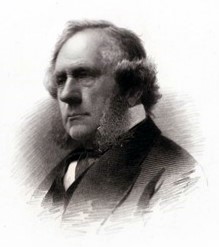Harper is an American publishing house, currently the flagship imprint of global publisher HarperCollins.
History
.jpg/220px-Fletcher,_James,_John,_and_Joseph_Harper_(ca._1860).jpg)
J. & J. Harper (1817â€"1833)
James Harper and his brother John, printers by training, started their book publishing business J. & J. Harper in 1817. Their two brothers, Joseph Wesley Harper and Fletcher Harper, joined them in the mid-1820s.
Harper & Brothers (1833â€"1962)
The company changed its name to "Harper & Brothers" in 1833. The headquarters of the publishing house were located at 331 Pearl Street, facing Franklin Square in Lower Manhattan (about where the Manhattan approach to the Brooklyn Bridge lies today).
Harper & Brothers began publishing Harper's New Monthly Magazine in 1850. The brothers also published Harper's Weekly (starting in 1857), Harper's Bazar (starting in 1867), and Harper's Young People (starting in 1879).
George B. M. Harvey became president of Harper's on Nov. 16, 1899.
Harper's New Monthly Magazine ultimately became Harper's Magazine, which is now published by the Harper's Magazine Foundation. Harper's Weekly was absorbed by The Independent (New York; later Boston) in 1916, which in turn merged with The Outlook in 1928. Harper's Bazar was sold to William Randolph Hearst in 1913 and is now Bazaar, published by the Hearst Corporation.
Harper & Row (1962â€"1990)
In 1962 Harper & Brothers merged with Row, Peterson & Company to become Harper & Row. Marshall Pickering was bought by Harper and Row in 1988. Marshall Pickering itself was formed in 1981 from two long established Christian publishers. Marshall Morgan and Scott, a London based predominantly Baptist publishing house, which had acquired a number of publishing companies over the years, such as Bagsters (Bible publishers since 1794) and Oliphants. Pickering and Inglis was a long established Glasgow based publisher, publishing largely for the non conformist church in Scotland with many Brethren publications..
HarperCollins (1990â€"present)
Rupert Murdoch's News Corporation acquired Harper & Row in 1987, and William Collins & Sons in 1990. The names of these two national publishing houses (Harper & Row in the United States and Collins in Britain) were combined (along with the Harper's torch icon and Collins' fountain icon) to create HarperCollins, which has since expanded its international reach with further acquisitions of formerly independent publishers. The Harper imprint began being used in place of HarperCollins in 2007.
Paperbacks
After the purchase of Harper & Row by News Corporation, HarperCollins launched a new mass market paperback line to complement its existing trade paperback Perennial imprint. It was known as Harper Paperbacks from 1990 to 2000, HarperTorch from 2000 to 2006, and Harper from 2007 to the present.
Authors

See also
- Harper & Row v. Nation Enterprises
- The Long Short Cut
- Brooks Thomas
References

Further reading

- Jacob Abbott (1855), The Harper Establishment, New York: Harper & Brothers, OCLCÂ 6798043Â
- Barnes, James J. "Edward Lytton Bulwer and the Publishing Firm of Harper & Brothers." American Literature (1966): 35-48. in JSTOR
- D’Amato, Martina. "“The Harper Establishmentâ€; or, How a New York Publishing Giant Was Made." Online
- Exman, Eugene. The brothers Harper: a unique publishing partnership and its impact upon the cultural life of America from 1817 to 1853 (Harper & Row, 1965)
- Eugene Exman (1967), The House of Harper, NY: Harper & Row, OCLCÂ 586430Â
- J. Henry Harper (1912), The House of Harper: a century of publishing in Franklin Square, New York: HarperÂ
Primary sources
- Harper & Brothers' List of Publications, New York: Harper & Brothers, 1859Â
External links

- Official website (US)
- Official website (UK)
- The Harper Brothers Founders of Harper Brothers Publishing

